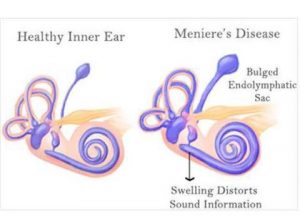About Menieres
Meniere’s disease is a chronic, vestibular (inner ear) disorder defined in 1995 by the Committee on Hearing and Equilibrium of the American Academy of Otolaryngology-Head and Neck Surgery as “the idiopathic syndrome of endolymphatic hydrops.”. In plain language, this means that Ménière’s disease results from increased inner ear pressure causing recurrent episodes of hearing loss, vertigo, tinnitus and fullness in the affected ear. Ménière’s disease can develop at any age, but it is more likely to occur in people of the age of 30 – 60 years.

Signs & Symptoms
Vertigo Episodes: The person suffering from Meniere’s disease experiences recurring episodes of vertigo. A spinning sensation that starts spontaneously ( know more ). These vertigo episodes last for about 20 minutes to several of hours. In general, a vertigo spell does not last for more than 24 hours. Acute vertigo bouts induce vomiting and nausea.
Loss of Hearing Ability: A fluctuant Hearing loss may occur in the earliest stages of Meniere’s disease. As the disease progresses with the time and left unattended, the temporary hearing loss may become a permanent disability.
Tinnitus (Or ringing in the ear): Tinnitus is a perceived sound of ringing, buzzing, roaring, whistling or hissing sound in the ear. These sounds are initially fluctuating but may become perpetual as the disease progresses.
Feeling of Fullness in the ear: Patients suffering from Meniere’s disease often feel pressure in the affected ear (aural fullness) or on the side of their heads before the spell of vertigo starts, and this decreases after vertigo spell subsides.
Diagnosis
To diagnose Meniere’s disease, the patient has to have had two vertigo episodes for 20 or more minutes in length, but not more than 24 hours. A hearing test is conducted to check the level of hearing. A trained medical practitioner checks for a feeling of fullness in the ear or ringing sensation (tinnitus).
There can be other symptoms of Meniere’s disease too. In any case, a thorough assessment alone can confirm Meniere’s disease. Tests like VNG (videorystagmography), ECochG (Electrocochleography) and Andiometry are required to give a defeaitive diagnosis.
Treatment
The treatment for Meniere’s disease focuses on relieving the symptoms of the disease.
DIETARY MODIFICATIONS: Patients are advised to take a diet which is low in salt and caffeine.
MEDICATION: Vestibular suppressants medications, such as meclizine/prochlorperazine or diazepam, may reduce the spinning sensation. Anti-nausea medications may be advised to control nausea and vomiting. Diuretics may be recommended to reduce inner ear pressure. Medicines like Betahistine are said to control the symptoms when given in high doses.
NONINVASIVE THERAPIES AND PROCEDURES VESTIBULAR REHABILITATION THERAPY
The patient can be assisted with customised vestibular rehabilitation treatments to resolve disequilibrium issues arising due to vertigo.
Hearing aidsHearing aids are devices to improve the hearing ability of the patient affected by the Meniere’s disease.
Meniett device Meniette Device generates pulsations to put pressure on the inner ear canals via ventilation tube. This way, the fluid movement improves, thus reducing pressure built up in the middle ear. The long-term effects of this therapy are still being studied. You can use this device at home for about 5 minutes, thrice a day. If the non-invasive therapies don’t much help with the condition, the doctor may prefer to put you on more aggressive means of treatment for Meniere’s disease.

Treatment
MIDDLE EAR INJECTIONS
The doctor injects the medicine into the middle ear which then seeps into the inner ear, providing relief from vertigo symptoms by decreasing the inner ear pressure. Intratympanic steroid and Gentamicin injections are widely used in intractable meniere’s disease. Gentamicin is injected in the middle ear leading to chemical labyrinthectomy( meaning, it affects the dark cells in the labyrinth that produce endolymph – inner ear fluid). Gentamicin decreases the inner ear pressure by reducing production of endolymph. The doctors perform this procedure under local anaesthesia. This results in reduced frequency and severity of vertigo episodes. IntratympanicGentamicin may cause hearing loss in the patient. If the patient already has decreased hearing ability, the procedure may not affect hearing much. Steroids, such as dexamethasone and methylprednisolone, also may help control vertigo attacks in some people. This procedure is also performed under local anaesthesia. Although steroids may be slightly less effective than gentamicin, they do not affect hearing.
SURGERY
Procedures: Endolymphatic sac procedure: The endolymphatic sac plays a significant role in controlling fluid level in the inner ear. The surgical procedure may effectively lessen vertigo by reducing the fluid collected within the inner ear. The procedure, endolymphatic sac decompression consists of removing a small fragment of bone from the endolymphatic sac. Sometimes, a tube is placed in the inner ear to drain the excess fluid, to help relieve the pressure from the ear canals.
Vestibular nerve section This procedure involves cutting the vestibular nerve in the inner ear, which is responsible for maintaining balance. This medical procedure relieves issues associated with vertigo spells while attempting to preserve hearing ability in the affected ear. The procedure requires administering of general anesthesia and an overnight hospitalization of the patient. The theory behind the surgery is to convert an unstable labyrinth into a stable non-functional labyrinth.
Labyrinthectomy This procedure best suits the patients who have severe hearing loss. The surgeon removes a section from the affected inner ear that governs balance and hearing ability.
